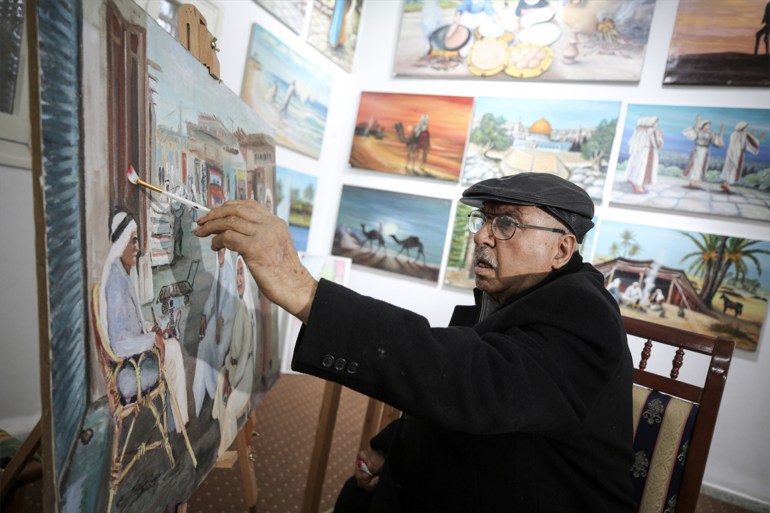Railways and trains, old markets, ancient buildings, fields of citrus and coastal vegetables, and others, are all models embodied in artistic paintings, which found a place on the walls of the house of the Palestinian artist, Muhammad al-Astal (84 years), where it includes a special exhibition that opened on Sunday.
The exhibition contains dozens of paintings drawn by Al-Astal, most of which document scenes of Palestinian life between 1940 and 1999, including buildings, fields, markets, birds, animals, customs, traditions, dancing, weddings, and others.
The artist Al-Astal drew dozens of paintings documenting Palestinian life between 1940 and 1999 (Anatolia)
250 paintings
Al-Astal devoted his life to art, photography and his journalistic work in his hometown of Khan Yunis in the southern Gaza Strip, in Kuwait, where he spent years, and in the United States, where he settled and completed his life, leaving behind the paintings signed in his name as a witness to the most beautiful decades that Palestinians lived in, in terms of customs and traditions.
Al-Astal dusted off his paintings to appear in the form of an art exhibition, after he transported them during his repeated visits to Gaza in recent years in bags to his hometown from the United States, amounting to about 250 paintings, and his counterpart remained in his residence, participating in art exhibitions.
In an interview with Anadolu Agency, Al-Astal said, "Since my childhood I was talented in drawing and excelled in my school in this aspect, and I have practiced drawing since I was ten years old."
He continued, "In 1956 I went to Egypt to study fine arts and stayed for 5 years, after which I returned to Gaza and opened a photography studio and studio that lasted from 1960 to 1967."
He added: Then I left for Kuwait in 1967, where I stayed for 24 years, and also opened a studio and a studio. I also worked as a photojournalist and painter for magazines including "Al-Arabi" and "Al-Moallem", and the Kuwaiti University magazine "Afaq".
Artist Al-Astal: I did not stop painting and did not sell or dispose of any painting (Anatolia)
Heritage Archive
The Palestinian artist said, "During the Gulf War, I moved to live in America, and throughout that period and before and after I did not stop painting, I focused on heritage paintings, and I did not sell or dispose of any painting, and most of it is realistic, I saw it with my eyes and kept it in my mind and painted it."
He continued, "During my repeated visits to the people in Gaza, I decided to transfer part of my paintings, and to turn my empty house into a permanent art exhibition for me, frequented by everyone at any time, and it became a shrine so that people could learn about the heritage and our old life."
He explained that "most of the scenes of life that I was able to draw in my paintings have disappeared, and only remained inside the paintings, so it is considered an important heritage archive, as it documented a time period of more than 50 years with its beauty and simplicity, everyone wishes that if he lived it or the wheel of life would turn back."
Al-Astal pointed out that his paintings were drawn on canvas paper, which resists the factors of time and maintains the quality and color of the painting over the years, with oil and acrylic colors, explaining that he owns more than 450 paintings, and he continues to paint despite his old age.
Artist Mohamed Al-Astal focused on traditional paintings (Anatolia)
Exhibition launch
He mentioned that some paintings took him an hour, and others needed days and perhaps months, depending on the nature of the scene and the free time he was allowed to paint during, explaining that he used to spend his nights and mornings drawing.
Al-Astal is in good health that made him able to follow the inauguration of his exhibition step by step and choose suitable lighting for him, and he expresses his overwhelming happiness to realize his dream of turning his home into an exhibition, through which scientific and historical interest can be achieved, bearing his name and the name of his country Palestine.

